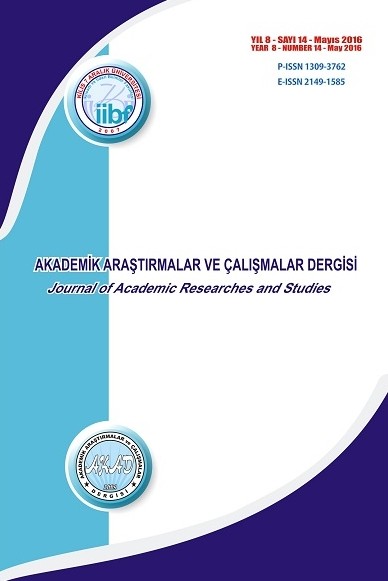TEKNOLOJİ VE REKABETÇİLİK: TEMEL KAVRAMLAR VE ENDEKSLER BAĞLAMINDA BİR DEĞERLENDİRME
Teknolojik Gelişme, Rekabetçilik Endeksleri, Küresel Rekabetçilik Sıralaması
___
- AIGINGER, K. (1997). “The Use of Unit Values to Discriminate between Price and Quality Competition”, Cambridge Journal of Economics, 21(5): 571-92.
- AKTAN, C. C. (2009). “Rekabet Gücü Kavramı”, www.canaktan.org/yeni-trendler/yeni-rekabet kavram.htm, (12.09.2009).
- ARCHIBUGI, D. and MICHIE J. (1998). “Technical Change, Growth and Trade: New Departures In Institutional Economics”, Journal of Economic Surveys, 12(3): 1-20.
- BALASSA, B. (1965). “Trade Liberalization and Revealed Comparative Advantage”, Manchester School of Economic and Social Studies, 33(2): 99–124.
- BEIJE, P. (1998). Technological Change in the Modern Economy, Edward Elgar Publishing, Inc., United Kingdom.
- CANTWELL, J. (2005). “Innovation and Competitiveness”, (Eds.) FAGERBERG, J., MOWERY, D. C. and NELSON, R. R., The Oxford Handbook of Innovation, Oxford University Press Inc., New York.
- DOSI, G. (1988). “Sources, Procedures, and Microeconomic Effects of Innovation”, Journal of Economic Literature, 26(3): 1120-1171.
- ERNST, D. and O'CONNOR, D. (1989). Technology and Global Competition, OECD, Paris.
- FAGERBERG, J. (1988). “International Competitiveness”, The Economic Journal, 98(391): 355-374.
- GOMULKA, S. (1990). The Theory of Technological Change and Economic Growth, Routledge, London.
- GREENHALGH, C., and ROGERS, M. (2010). Innovation, Intellectual Property and Economic Growth, Princeton University Press, United Kingdom.
- GROSSMAN, G. M. and HELPMAN, E. (1989), “Product Development and International Trade, Journal of Political Economy, 97(6): 1261-1283.
- GROSSMAN, G. M. and HELPMAN, E. (1991). Innovation and Growth in the Global Economy, MIT Press, Cambridge.
- HOEKMAN, B. and JAVORCIK, B. S. (2006). “Lessons From Empirical Research on International Technology Diffusion Through Trade and Foreign Direct Investment”, (Eds.) HOEKMAN, B., and JAVORCIK, B. S., Global Integration and Technology Transfer, The World Bank and Palgrave Macmillan, New York.
- IMD (2013). Word Competitiveness Yearbook 2013, IMD World Competitiveness Center, Switzerland, http://www.conicyt.cl/wp-content/uploads/ 2013/07/WCY_ 2013.pdf, (28.03.2015)
- IMD (2014). Word Competitiveness Yearbook 2014, IMD World Competitiveness Center, Switzerland, http://www.conicyt.cl/wp-content/uploads/ 2014/07/WCY-2014.pdf, (28.03.2015)
- IMD (2015). 2014 World Competitiveness Yearbook Ranking, http://www.imd. org/news/2014-World-Competitiveness.cfm, (28.03.2015)
- JAFFE, A. B. (1986). “Technological Opportunity and Spillovers of R & D: Evidence from Firms' Patents, Profits, and Market Value”, The American Economic Review, 76 (5): 984-1001.
- JONES, C. I. (2007). İktisadi Büyümeye Giriş, (Çev.) ATEŞ Ş. ve TUNCER İ., Literatür Yayınları, İstanbul.
- KEESING, D. B. (1965). “Labor Skills and International Trade: Evaluating Many Trade Flows with a Single Measuring Device”, The Review of Economics and Statistics, 47(3): 287-294.
- KENEN, P. B. (1965). Nature, Capital, and Trade, The Journal of Political Economy, 73(5): 437-460.
- KİBRİTÇİOĞLU, A. (1996). Uluslararası (Makro) İktisat – Okumalar, AÜ Siyasal Bilgiler Fakültesi Y., Ankara, http://econwpa.repec.org/eps/it/ papers/ 0509/0509008.pdf, (25.05.2015)
- KONYA TİCARET ODASI (2006). Rekabet Gücü Endeksi ve Türkiye, KTO Yayınları, Konya.
- KRUGMAN, P. (1979). A Model of Innovation, Technology Transfer, and the World Distribution of Income, The Journal of Political Economy, 87(2): 253-266.
- LALL, S. (2000). Turkish Performance in Exporting Manufactures: A Comparative Structural Analysis, QEH Working Paper Series, QEHWPS47.
- LALL, S. (2001). Competitiveness, Technology and Skill, Edward Elgar Publishing, Inc., USA.
- LIESNER, H. H. (1958). “The European Common Market and British Industry”, The Economic Journal, 68(270): 302-316.
- LIU, S., FANG, Z., SHI, H. and GUO, B. (2010). Theory of Science and Technology Transfer and Applications, Taylor and Francis Group, New York.
- MELICIANI, V. (2001). Technology, Trade and Growth in OECD Countries: Does Specialisation Matter?, Routledge, New York.
- PORTER, M. E. (1990). The Competitive Advantage of Nations, A Division of Macmillan, Inc., New York.
- POSNER, M. V. (1961). International Trade and Technical Change, Oxford Economic Papers, 13(3): 323–341.
- REDDING, S. J. (2002). “Path Dependence, Endogenous Innovation, and Growth”. International Economic Review, 43(4): 1215-1248.
- ROLAND, A. (1992). “Theories and Models of Technological Change: Semantics and Substance”, Science, Technology & Human Values, 17(1): 79-100.
- ROSENBERG, N. (1982). Inside The Black Box: Technology and Economics, Cambridge University Press, New York.
- SAGGI, K. (2006). “Foreign Direct Investment, Linkages, and Technology Spillovers”, (Eds.) HOEKMAN, B., and JAVORCIK, B. S., Global Integration and Technology Transfer, The World Bank and Palgrave Macmillan, New York.
- SEYİDOĞLU, H. (2007). Uluslararası İktisat Teori, Politika ve Uygulama, Güzem Can Yayınları. İstanbul.
- SMITH, K. (1994). “New Directions in Research and Technology Policy: Identifying the Key Issues”, STEP Report, The STEP-Group, Oslo.
- TÜRKCAN, E. (2009). Dünya’da ve Türkiye’de Bilim, Teknoloji ve Politika, İstanbul Bilgi Üniversitesi Yayınları, İstanbul.
- VERNON, R. (1966). “International Investment and International Trade in the Product Cycle”, The Quarterly Journal of Economics, 80(2): 190-207.
- WEF (2012). The Global Competitiveness Report 2012-2013, World Economic Forum, Genova, http://www3.weforum.org/docs/WEF_Global CompetitivenessReport_2012-13.pdf, (28.03.2015)
- WEF (2013). The Global Competitiveness Report 2013-2014, World Economic Forum, Genova, http://www3.weforum.org/docs/WEF_Global Competitiveness Report _2013-14.pdf, (28.03.2015)
- WEF (2014). The Global Competitiveness Report 2014-2015, World Economic Forum, Genova, http://www3.weforum.org/docs/WEF_Global CompetitivenessReport_2014-15.pdf, (28.03.2015)
- YENTÜRK, N. (1991). “Teknoloji-Yoğun Mallar Açısından Türk Sanayiinin Rekabet Gücü, Gelişme Stratejileri ve Politika Önerileri”, 1991 Sanayi Kongresi Bildiriler Kitabı, Yayın No: 148-1, TMMOB Y., Ankara, (Kasım 1991): 247-260.
- ISSN: 1309-3762
- Yayın Aralığı: Yılda 2 Sayı
- Başlangıç: 2009
- Yayıncı: Kilis 7 Aralık Üniversitesi
TÜRKİYE’DE REEL DÖVİZ KURU VE DIŞ TİCARET İLİŞKİSİNİN VAR ANALİZİ İLE İNCELENMESİ
ANA AKIM (ORTODOKS-NEOKLASİK) İKTİSAT ÖĞRETİSİ ELEŞTİRİSİ: HETEREDOKS YAKLAŞIM İHTİYACI
ÜNİVERSİTE ÖĞRENCİLERİNİN CEP TELEFONU TERCİHLERİNİ ETKİLEYEN FAKTÖRLER VE BİR UYGULAMA
ARJANTİN OMBUDSMANI: YAPISAL-KURUMSAL VE İŞLEVSEL YÖNLERİ
TÜRKİYE’DE İSTİHDAMIN SEKTÖREL BELİRLEYİCİLERİ
Ali TÜFEKÇİ, Süleyman ŞAHİN, Esma GÜLTEKİN, Mehmet TEMİZ
DOĞRUDAN YABANCI YATIRIMLARIN SOSYO-POLİTİK BELİRLEYİCİLERİ ÜZERİNE BİR ANALİZ
TEKNOLOJİ VE REKABETÇİLİK: TEMEL KAVRAMLAR VE ENDEKSLER BAĞLAMINDA BİR DEĞERLENDİRME
